|
Designed
for 1024x768 by
archeophotography.com
Homepage
|
|
The
Mystery of the Crystal Skulls
Please click on a picture to
enlarge
and read the Copyright
notices, that I gathered here.
|
A lot of mysteries surround the Crystal Skulls.
Especially the Mitchell-Hedges Skull became famous in the 1990s as the
question was brought forward on how the ancient people could work with
something as hard as quartz in order to fabricate the skulls, as they
had no tools that could cut or polish them. In short, the skulls didn't
fit in the archeological views. Three of the four of the big skulls are
in museums, while the most famous - the afore mentioned Mitchell-Hegdes
Skull is in a private collection. One is in the British Museum, another
resides in a museum in Paris and the Third is in the Smithonian
Collection in Washington DC, USA.
In 1990 an excellent and thorough video documentary was made about the
Mitchell-Hedges Skull called "The Crystal Skull of Lubantuun".
After this documentary two different groups "jumped" on the Crystal
Skull bandwagon. On the one side the New Age enthusiasts that blindly
believe everything extraordinary and then - of course - the skeptics
that think we know everything about everything and there are no
mysteries left to explore.
In the following article, I would like to show you that the truth might
be right in the middle of those two opposing views.
In modern views of Archaeological research all of the skulls are modern
time fakes dating back to the early years of the 20th century. Case
closed. Many of the statements and research is shown
on the Wikipedia article, that you can read by clicking this link.
But is this really the full story? I always get really nervous if
articles, like the Wikipedia one, is very one sided and dismisses
everything else. This goes either way, I'm also cautious from all the
New Age claims of crystal healing powers and the likes.
First we have to establish that the statement made in the Wiki article
that under the Microscope one can find fine tool marks (some with metal
tools) hence it has to be a modern fake, is a wrong conclusion. The
only thing it tells us is that the skull(s) were not made with tools
that modern Archaeology says the Ancient people had. But didn't we
already know that? Wasn't the claim always that the ancients couldn't
have made the skulls, because they didn't have the tools?
If you think logically, that still leaves two possibilities:
1. The Skulls are indeed made in modern times and therefore considered
a fake. No more explanation needed.
2. The Skulls are ancient, but not made with the tools the
Archaeologist say the Ancient people had.
|
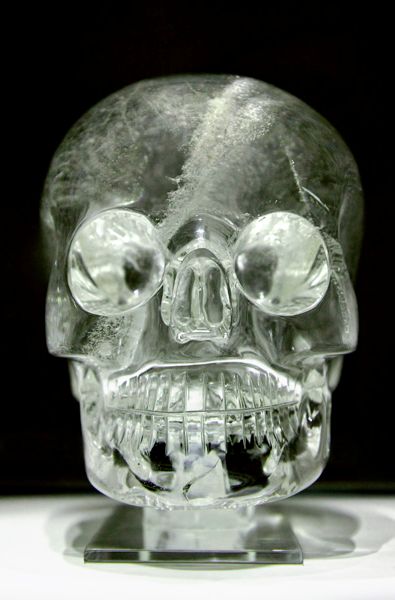 Crystal Skull in the British Museum.
Crystal Skull in the British Museum.
Source: Wikipedia Commons
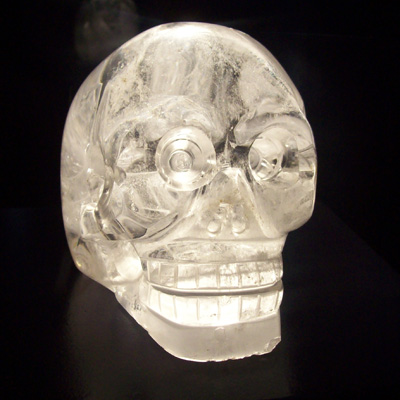 Crystal Skull in Musée du quai Branly, Paris
Crystal Skull in Musée du quai Branly, Paris
Source: Wikipedia Commons |
If no. 1 is correct, don't we have to ask ourselves
why on earth somebody got an idea in the 1900-1930s to manufacture
Crystal skulls? I mean one skull would be a cute oddity, but four?
Quartz crystal is a material that was never easy to work with. Quartz
is one of the hardest materials known to man, exeeded only by Diamond,
Rubies (also called Corundum) and Topaz. And why say they are coming
from latin America? If somebody fakes a crystal skull, wouldn't they
have been just as enigmatic if they came out of Africa? Like Egypt,
which held just as much mystery. Or the deep jungles of India. China
maybe. No, the 'faker's "decided" they came out of Latin America.
If no. 2 is correct, the implications would be
enormous, not matter how you look at it. It means that the Ancient
people in Central America had more tools as the Archaeologists think.
It means that they knew other metals other than bronze AND they knew
how to work with something as hard as quartz. OR they had help from
another source.
At any rate, the key question always has been: Did the ancient people
in Central America have the ability to work with quartz, or is it all
"debunked".
During my visits in the various Museums of the world I came across very
intersting artifacts that proof - without the shadow of a doubt - that
the ancient people in Central America did in fact work with quartz. The
following artifacts I have never seen in any article, book, magazine or
movie that wants to convince everybody that ALL the Crystal skulls are
modern fakes. I think this information is deliberately withheld and
that's why I would like to present it to you.
Let's start
out with a whole
quartz necklace that I photographed in the National Museum of Ecuador
in the capital Quito. As you can see the the Necklace is made out of 19
artificially rounded quartz spheres. Each sphere has a hole drilled
through the middle in order to thread a string through. Now as I said
earlier, this is not a small feat, of you have no diamond drill, since
quartz is so hard. Sand you find on a beach is basically rock
pulverized by nature over millions of years. This rock also contained
quartz and if you look at sand more closely, you can see the tiny
quartz pieces. It's the hardness of the quartz that makes sand great a
good abbresive. Sandblasting wouldn't work if it wouldn't be for the
Quartz in the sand. A whole
different set of problems are the holes in the middle of the spheres.
Think about it. What do you use to get the hole started and keep going
to drill through? The official explanation is a wooden stick with sand
thrown in.
If you are interested in testing this theory of the official
Archaeologists, I urge you to go to your closest rock shop and get
yourself some smoke quartz for a few Dollars. Get yourself some sand
and a stick and start drilling. I guarantee you to will stop when your
hands are getting bloody and you realize that you haven't even
scratched the surface of your rock.
Yet, the necklace is relatively simple in its complexity of workmanship
and it could be argued that with enough time and patience the artist
was able to it by hand and the tools described above. If you look
closer at the holes through the stone (it helps that the quartz is
translucent) you can see that they are uneven, cone shaped and do
indeed look like hand carved. This is in stark contrast to another
bracelet that I photographed in Lima Peru. It's a stunning piece of
great precision, just like the next
object(s) I want to present to you: |
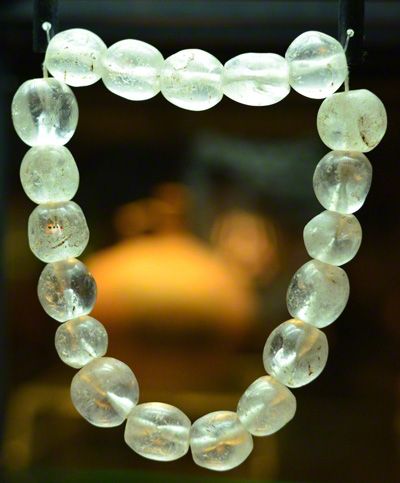
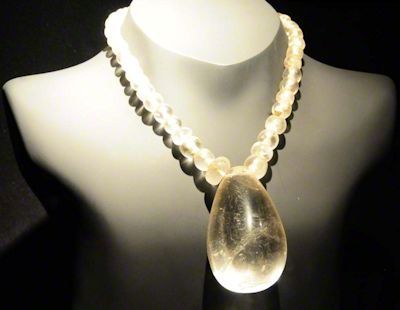 |
Next up is
a little frog made out of smoke quartz, photographed in the
Anthropology Museum of Mexico City. This little guy is about 8
centimeters long. No matter how small an artifact is, the hardness of
the stone stays always the same. The geometry and detail of the
workmanship is absolutely outstanding in every respect and hard to
imagine without metal and diamond tools. The intigrate detail around
the eyes, the mouth, the feet and back section are so fantastic that it
is hard to believe this was carved and polished by hand.
The other problem of a material as hard as quartz I have not touched
on, yet.
The harder a material gets the more briddle it becomes. Every diamond
cutter knows that. Every big diamond that is cut is studied for days
and weeks before the diamond cutter lays their first hand on it. If the
stone is cut or worked against it's "grain" and the natural structure
of the stone, it can burst into thousand pieces.
Quartz is not different than diamond in this respect. It's natural
properties are very similar.
This meanse that not only had the artist unbelievable patience in
working the frog pictured on the right, but also must have had great
knowledge (and experience) working with quartz. It's also very hard to
imagine how the artist would have carved out all the integrate detail
on the frog with just sand and sticks rubbed on the stone. It's one
thing to drill a whole (where the snad and stick method makes at least
theoretical sense) but to carve out minute detail with symmetrical
precision.
If you think this is great, the next object will blow you away...
|
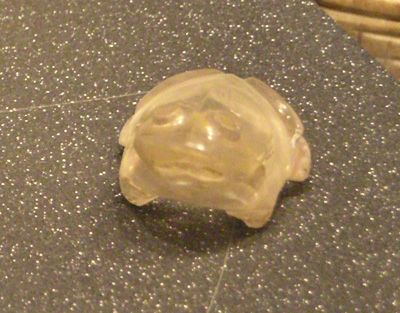
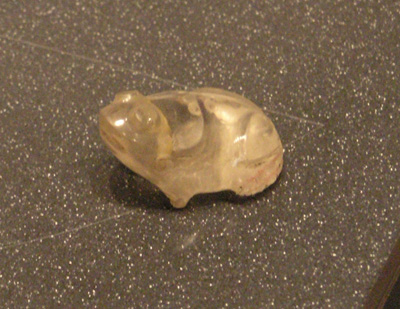 |
This almost avantgarde looking
object made of quartz can also be viewed in the Anthropological museum
of Mexico City. It is made with a quality and precision that leaves
you breathless. The object is about 15 centimeters long and 10
centimeters high.
I'm not quite sure what it depicts. From some angles (lower photo) it
looks like a face and from some angles (top photo) it resembles a small
animal, like a rabbit of sorts.
The most stunning part of the object is the way the surface is
finished. It really looks like it was made yesterday.
|
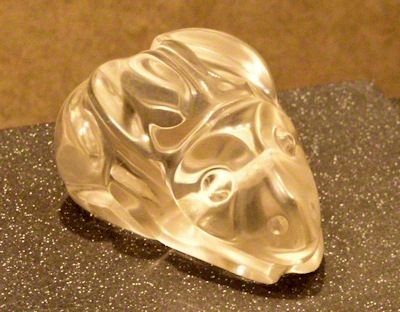
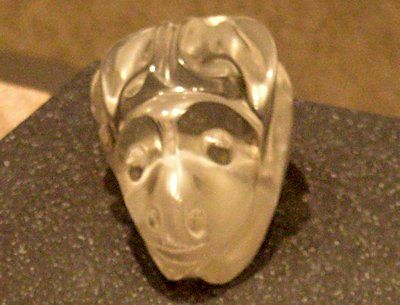
|
But on to
what you are really here for, the Mystery of the Crystal Skulls.
The real mystery, not the Indiana Jones one.
On the right you see a real, undisputed, guaranteed genuine (even by
archaeologists) Crystal skull from ancient Mesoamerica. Again
photographed in the Anthropology Museum of Mexico City.
I apologize for the slightly blurry images, but those photos are from a
few years back. Digital cameras have autofocus problems with Crystal
objects (and this is not a conspirace theory :) to begin with and the
extreme low light environment doesn't help either. But I think the
images show enough detail for the intersted viewer to see what the
items are all about.
|
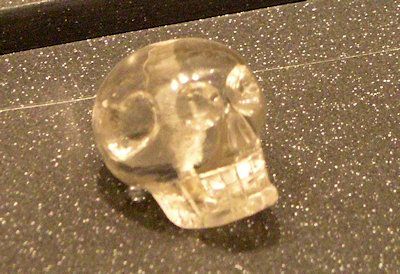
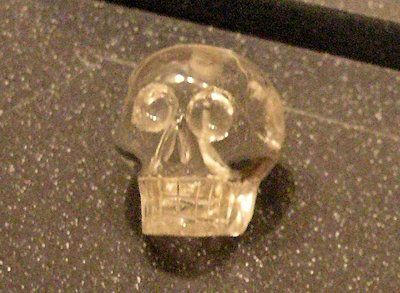
|
The Mexico City Museum houses a
second crystal skull. About 5cm in diameter, this skull has a hole
drilled from the top to the bottom. Of course these smaller skulls are
less spectacular compared to their bigger counterparts, but they are
not less interesting as they show the same intigrate detail as the
bigger controversial ones. The authentisity of these smaller skulls is
undisputed.
|
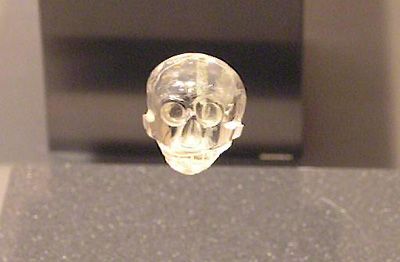
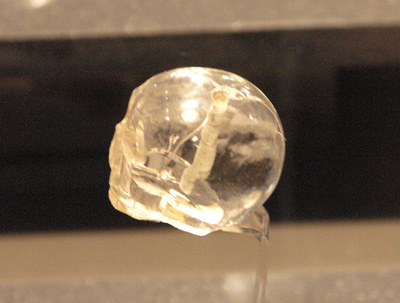
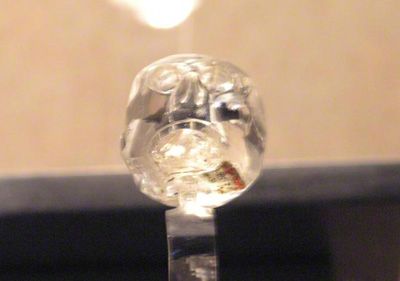
|
The
ancient crystal mystery doesn't stop here, though. The ancient people
had some indepth knowledge about working with quartz crystal and it's
properties and here is are two more examples. The first two examples
show an optical lens made out of quartz crystal. This artifact is
housed in the British Museum in London. It is also called the Nirud
Lens. The lens was not found in MesoAmerica but in ancient Irak during
the excavation of Niniveh and Babylon. The first two photos on the left
show this lens. Like the smaller Crystal Skulls of Mexico above
th Nimrud Lens is undisputed in archaeological circles.
The Nimrud lens is known since te late 1800s and was always regarded as
an oddity that shows the genius of the ancient people. As a side note I
just want to mention that the lens was found in the same area as the
famous ancient battery that is housed in the National Museum of Irak in
Baghdad.
But not only ancient Irak seemed to have known about the optical
Properties of quartz Chrystal. To my astonishement I found two optical
lenses in the Anthropological Museum of Lima in Peru. The lenses are
about 3/4 the size of the Nimrud lens and are Convex (outward curving)
instead of Concave (inward curving)
I'm pretty certain that here on paleoseti.com is the only place you can
see the ancient Peruvian lenses on the internet.
|
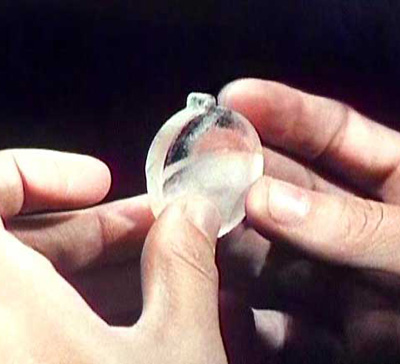
Above and below: The Nimrud lens in the British
Museum, London.
Both images courtesy of the British Museum
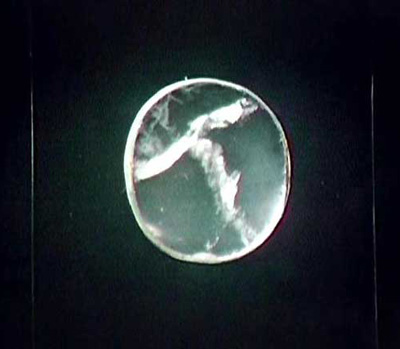
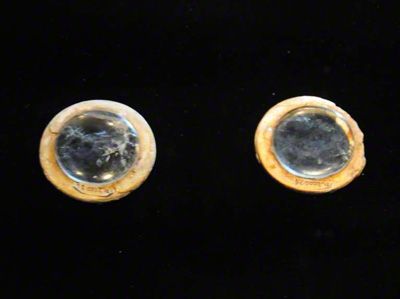
Above and below: The optical lenses from the Lima
Anthropological museum , Peru
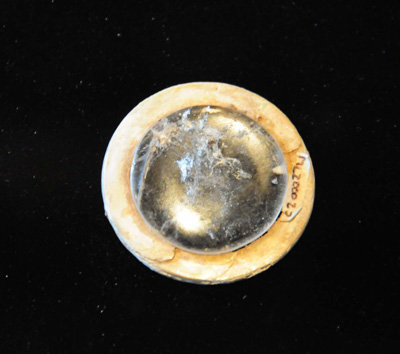
|
I find it absolutely amazing that no Google search
on the Crystal skulls, no online enzyclopedia article (Wikipedia and
Encyclopedia Britannica) brings up any of the above objects. They don't
seem to exist, no matter if the article is written by "New Age
enthusiasts" or the usual "debunkers" that think everything is fake
that doesn't fit in the usual scheme.
In this context it is extremely important to know that there is an
unwritten rule among Archaeologists. If an object is not found during
an official archaeological excavation,
it is assumed to be not genuine. Only in very rare cases does official
Archaeology acknowledge items that have not been found during
excavations. The last item of significance that I'm aware of is
acknowledged to be genuine was the "Sky Disk of Nebra" in Germany. But
even in this case there are "pockets of resistance" among a few
"hardliners" that will probably never acknowledge it to be genuine.
The reason for that is simple. Grave robbers and black market antiquity
dealers (a problem for Archaeology ever since the first Pyramids have
been built) should be discouraged to dig up items and sell it for a lot
of money.
The fact that pretty much all of the big museums in the world - be it
the Vatican Museum, British museum you name it - is full of items that
where "collected" without the permission of the countries they were
collected from doesn't really concern those same hardliners. But that's
a different story.
Back to the Crystal skulls. None of the aforementioned big skulls
(British Museum, Paris, Mitchell-Hedges) where actually found and
documented during official excavations. Therefore they where never
accepted to be geniune. To me it is amazing and surprising that the
skulls where examined over and over again up to the 1990s and not once
any tool marks have been found. All over sudden it is stated that
toolmarks can be seen an all the skulls rendering them fakes.
Yes, there where technical advancements in the last ten years, but in
the 1990s technology was advanced enough to detect tool marks, no
problem. Electron microscopes were able to detect viruses and items on
an atomic levels, but the tool marks on the skulls they missed. Very
awkward.
The most interesting piece of the puzzle to me is that the above
mentioned quartz artifacts that I photographed in the various museums
have been found during official excavations and nobody has ever
disputed their authenticity. I'm also not aware that anybody had tested
the any of the above artifacts for toolmarks. Wouldn't it be
interesting for any scientist, not just archaeologists, to see if they
exhibit the same toolmarks as they claim to have found on the big
skulls? Are they afraid to find the same tool marks on those lesser
known artifacts and they have to rewrite some of our ancient history? But
this is not how the story ends. There is still the question of why
Quartz was in such high regards among the anient peoples. What was so
special about it. It's certainly true that Quartz looks fabulous
because it's translucent, but I think we make it ourselves too easy by
saying it was valued, because it's "pretty". Many of the ancient
peoples all around the globe claimed that Quartz was the 'stone of the
Gods', just like Gold was the 'metal of the Gods'. What makes Quartz
and Gold so special? I'm
convinced that this has something to do with the universal properties
of both substances in electronics. In fact Quartz (and Gold) are the
two components that make any type of modern electronic device work.
Quartz literally makes everything "tick". The best example for this are
Quartz watches. In a Quartz watch or clock, Quartz crystals are used to
regulate electronic oscillators. WIth such a crystal oscillator, very
precise frequencies can be created that make timepieces of stunning
accuracy possible. Today we are used to cheap watches with Quartz
movements, but when they first came out as wristwatches in the late
1960s, they were a sensation. Quartz oscillators were in use from the
1930s on. In fact during the second world war most of the Quartz used
in modern applications came from South America. Modern
computer technology wouldn't be possible without Quartz or Gold. For
critical high end electronic applications gold is still the best
material as it is an excellent conductor. Quartz crystals are in pretty
much every modern computing device as they provide the internal 'heart
beat' for the processors. Does
history repeat itself? Was Quartz so special to the ancients because
the 'gods' needed it for their applications? Is that the reason the
ancient people regarded it so highly although those 'gods' already
left?
In this article I wanted to show you that there is much more to the
story of the Crystal skulls than meets the eye. Since I have never seen
any of the big skulls for myself, I can't decide if they are geniune,
old artifacts or not. The Crystal artifacts that I have seen are real
and it seems to me that a lot more research is needed to determine if
the big skulls are ancient or not. This needs to be done by comparing
the above items with the skulls in question. I think the only way to do
this is to send ALL the Crystal Quartz artifacts to an
independent lab that is not biased to one opinion or the
other.
|
|

